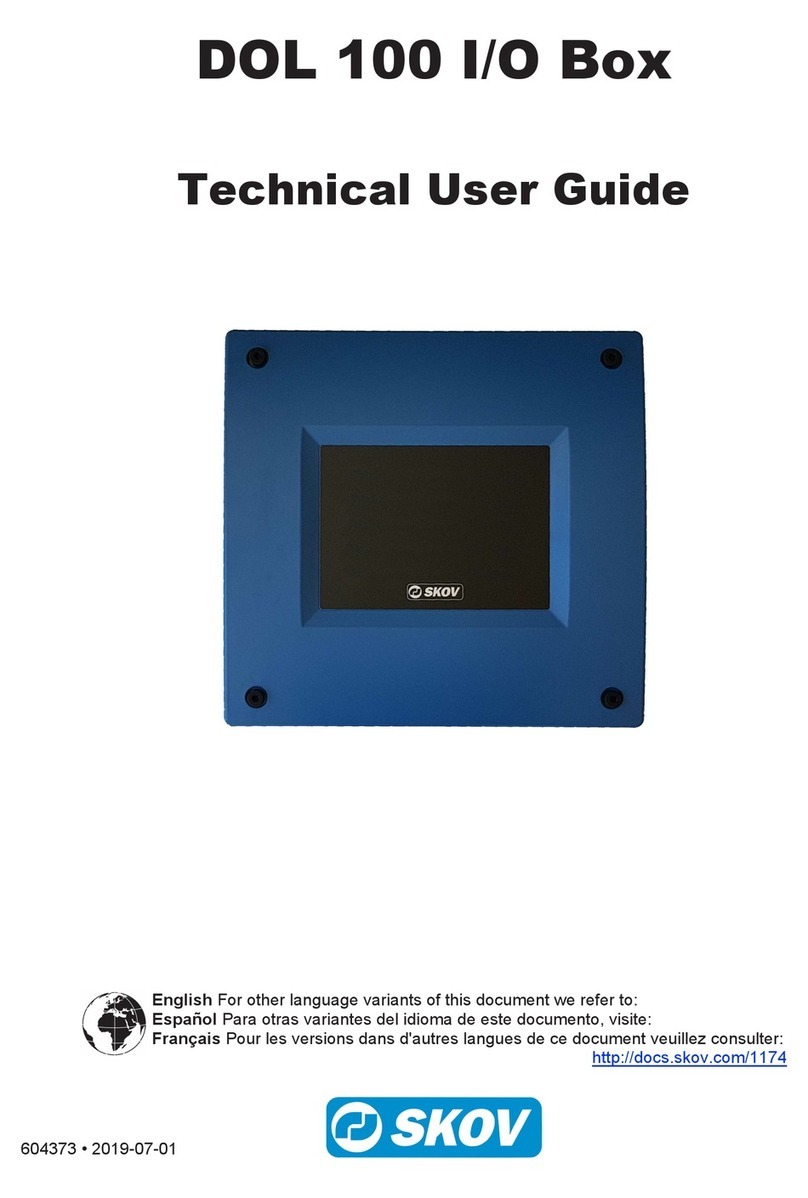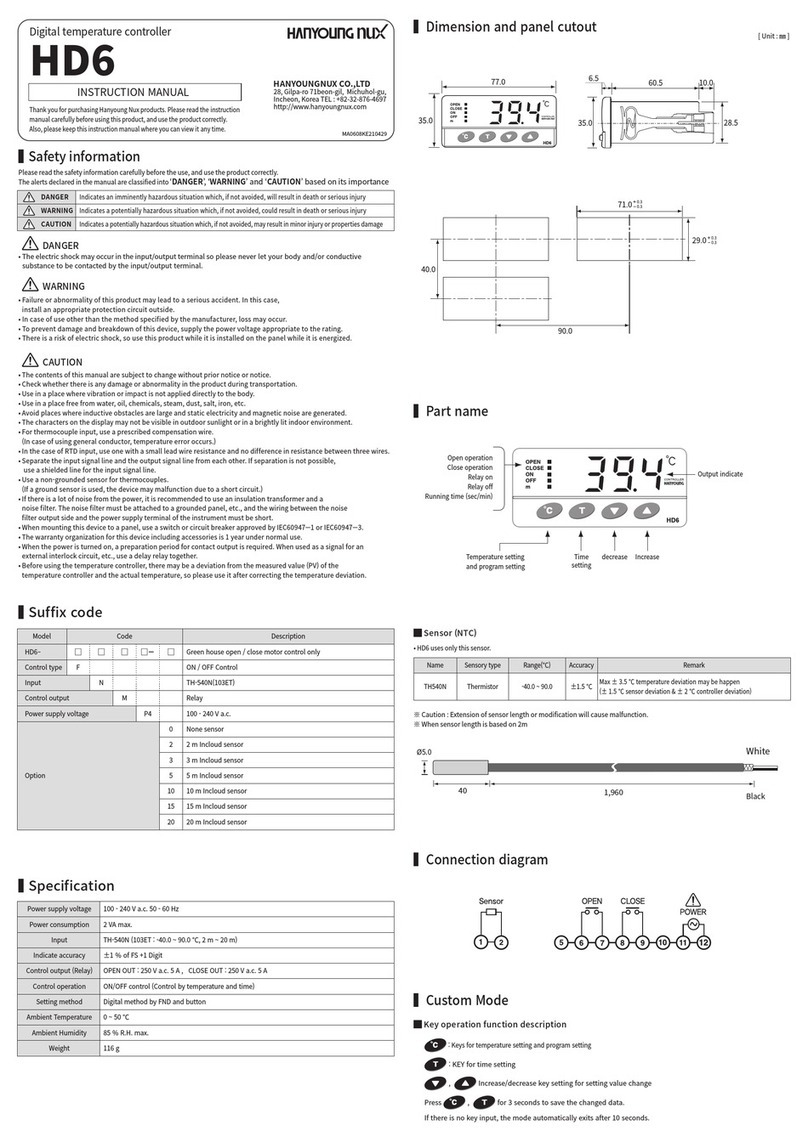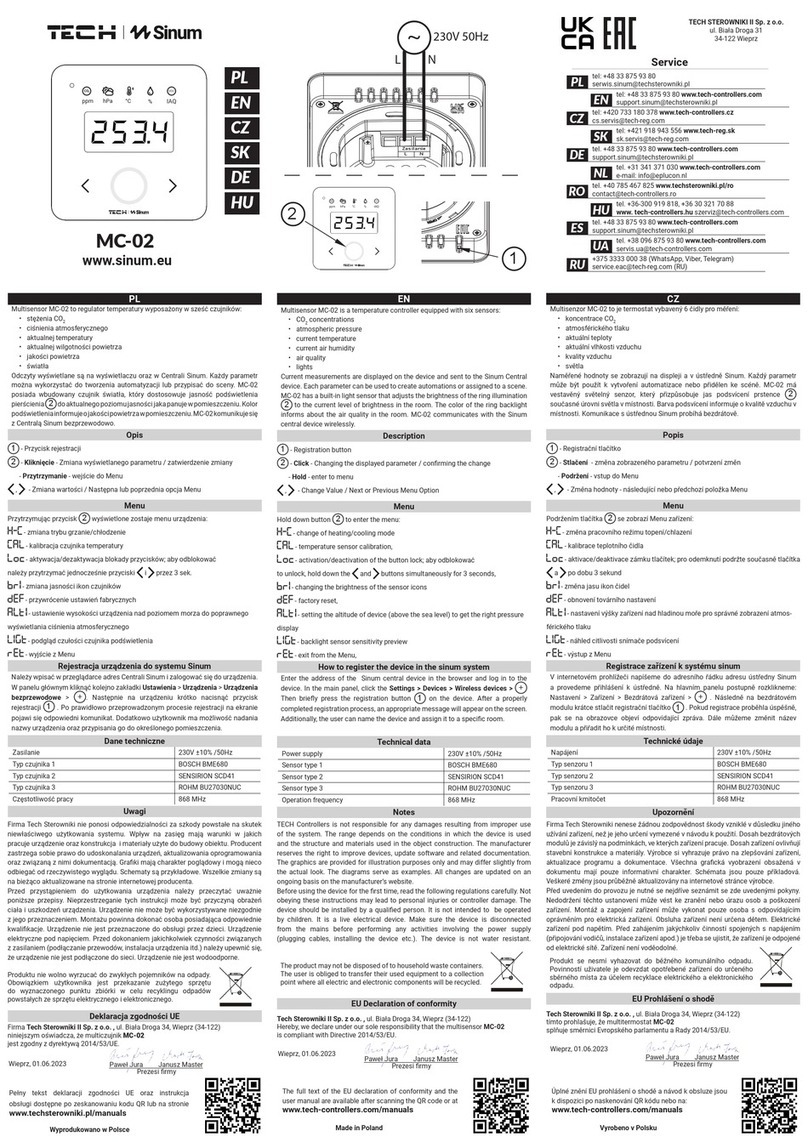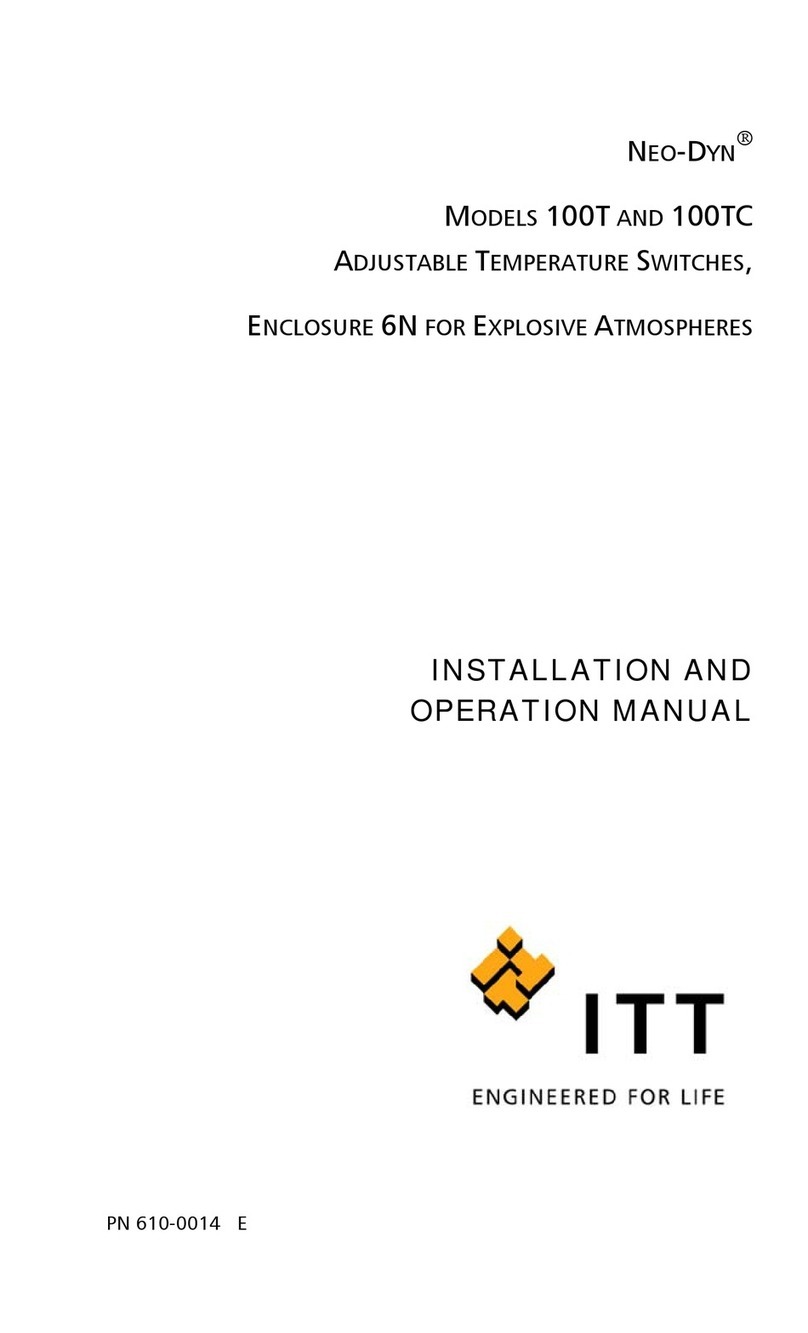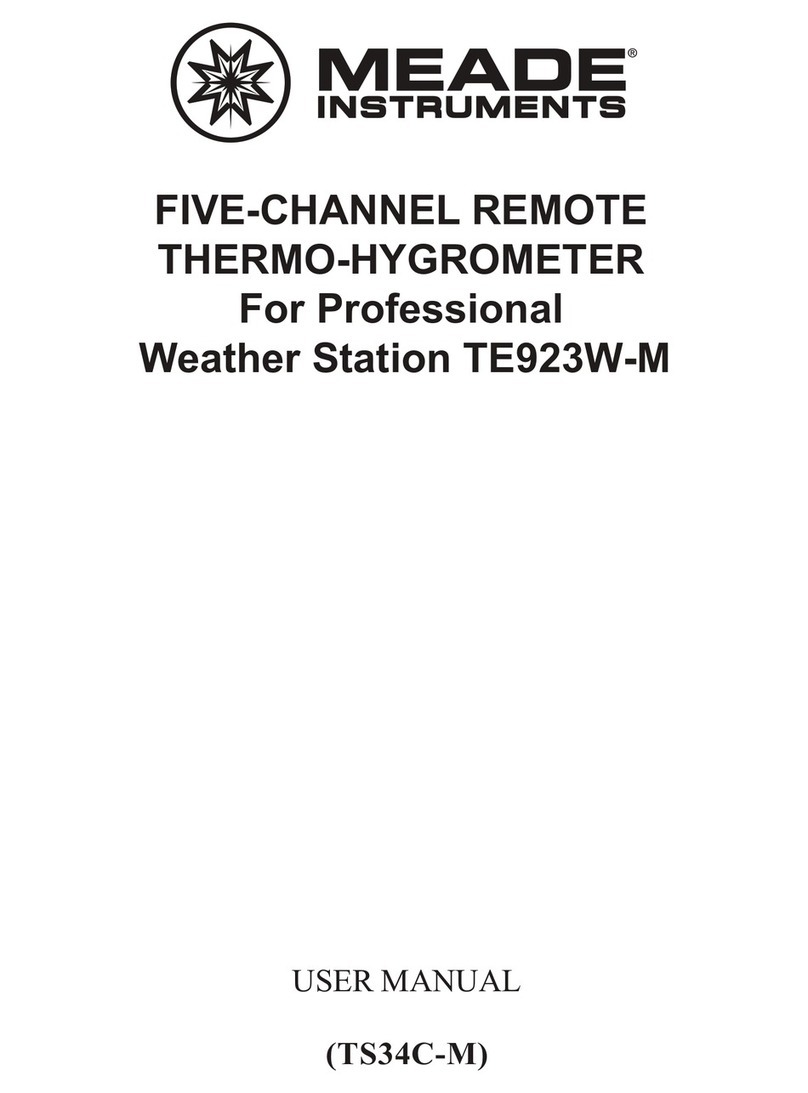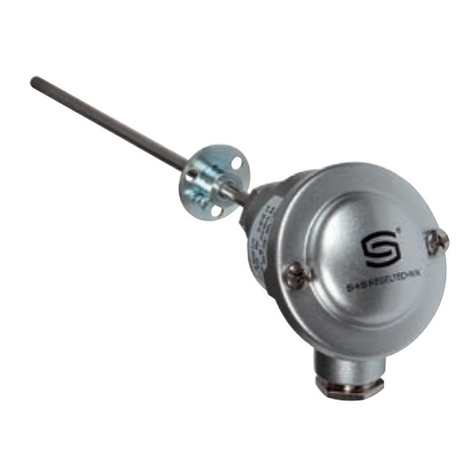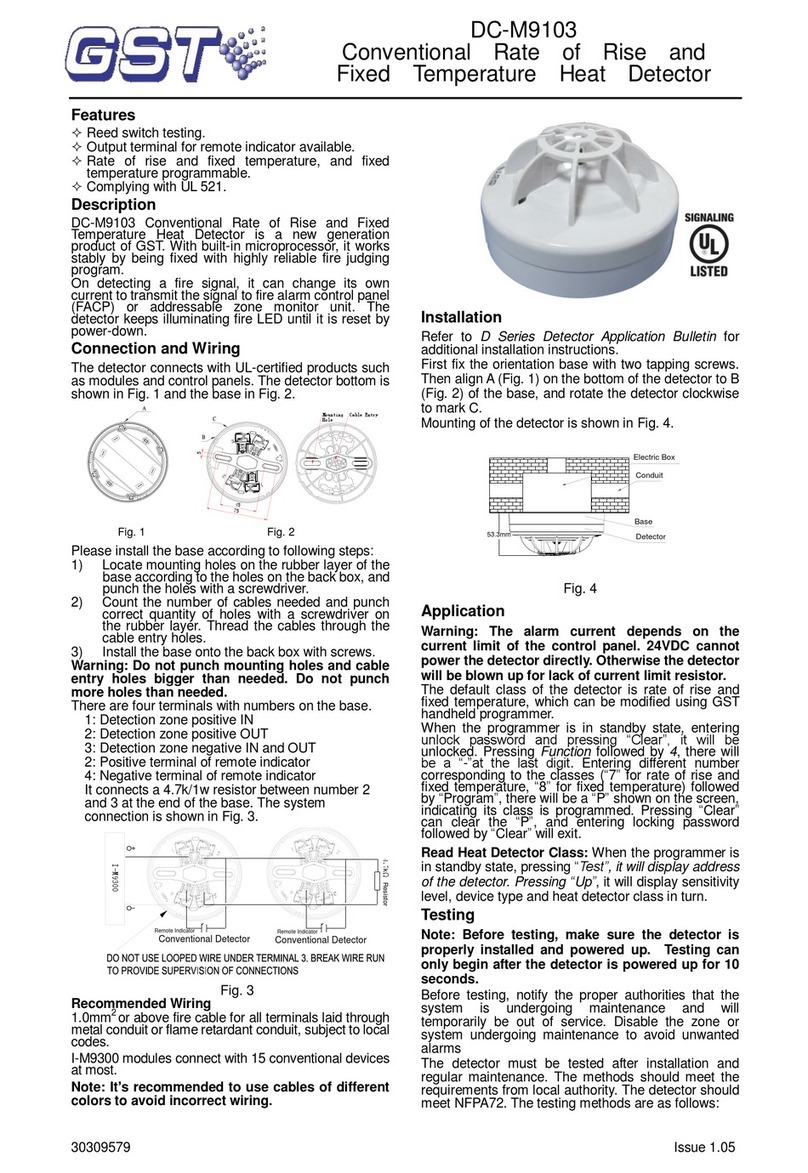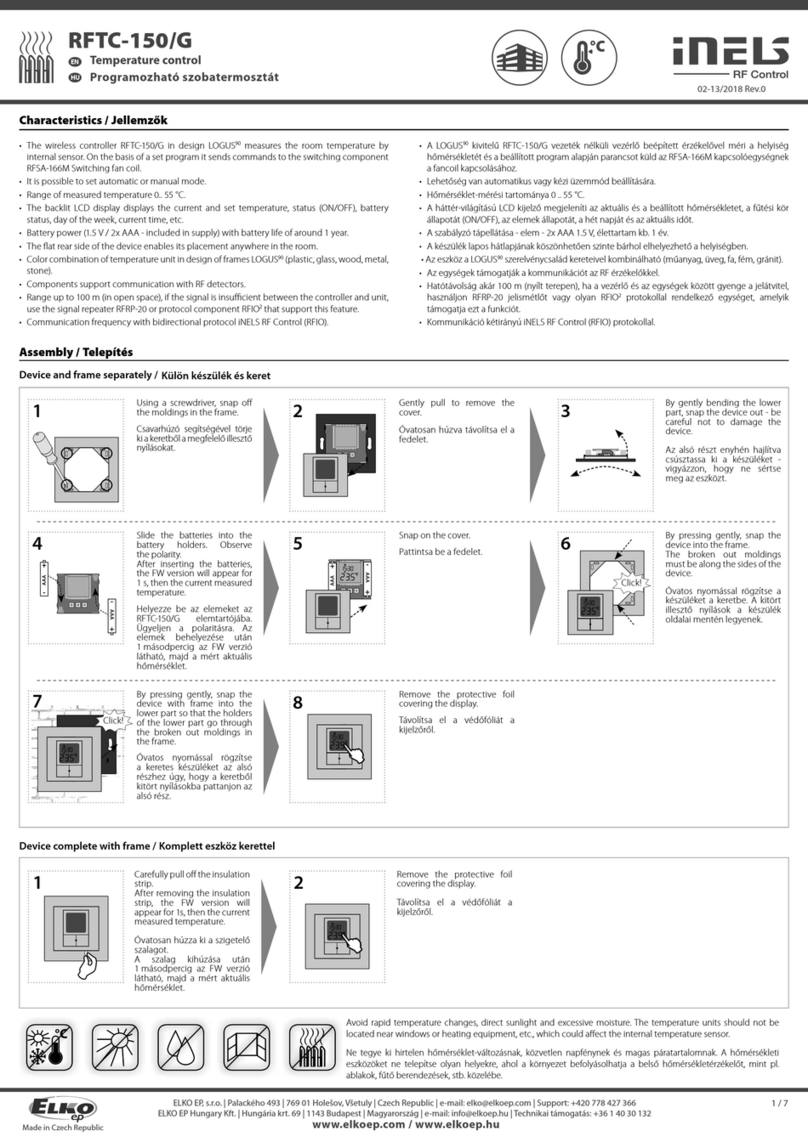Patol 5000 Series User manual

1D1145-3
SERIES 5000
Model 5410 Infra-red Transit Heat Sensor
Contact Details:
Patol Limited
Archway House
Bath Road
Padworth, Reading
Berkshire
RG7 5HR
Tel: +44 (0)1189 701 701
Fax: +44 (0)1189 701 700
Web: www.Patol.co.uk
Issue Change Date Remarks
1 Original 18/03/09 Based on D1140
2Table 3 - reference corrected to D 15/11/12 Page 8
3New document format 18/12/14
MANUAL
INSTALLATION - COMISSIONING
OPERATION - MAINTENANCE
Applicable to Unit Part Numbers 720-002 / 720-012
Serial Numbers 98538-01 onwards

2D1145-3
SERIES 5000
INDEX
1. INTRODUCTION
1.1 General
1.2 Principles
2. EQUIPMENT DETAIL
2.1 General Description
2.2 Relay Mode
2.3 Low Power Mode
2.4 Sensor Arrangement
2.5 Specification
2.6 Operational Programmability - SIL Switch
2.7 Connections
3. INSTALLATION
3.1 Detection Coverage
3.2 Supply / Signal Cable
3.3 Purge Air Supply
4. COMMISSIONING
4.1 Cable Checks
4.2 Controller Set Up
4.3 Power Up Procedure
4.4 Purge Air Supply and Pressure Switch
4.5 Hot Body Simulation Tests
5. OPERATION
5.1 Normal
5.2 Alarm Condition
5.3 Reset
5.4 Fault Warning
5.5 Test
6. MAINTENANCE
6.1 General
6.2 Purge Air Filter
6.3 Fault Monitoring Functions
6.4 Infra-red Detection

3D1145-3
SERIES 5000
1 INTRODUCTION
1.1 General
The Patol 5000 Series of equipment is specifically designed for the protection of establishments and
systems where a movement of materials with a potential fire hazard is a routine occurrence.
The 5410 Sensor employs enhanced Infra-red monitoring technology that enables the detection of fire
initiating materials, whilst they are being transported, and before they have reached a flame condition.
The system has many applications within industries such as Power Generation, Coal Mining, Process
Plant, Road Transportation and Rail Networks and has been specifically designed to both meet the rigors
of these environments and to provide the reliability required.
The equipment monitors for fire and fire potential of materials in transit. The system can detect anomalies
where combustion has not yet been reached, but where there is sufficient energy for a fire initiation upon
destination arrival.
A typical example is in the coal feed systems on power stations where coal on the ‘out field stack’ may
very well smoulder with little adverse effect for long periods of time. However, if imported to the power
station it may have devastating effects on conveyor systems, holding hoppers, blending plants etc.
Detection of hazards at temperatures below flame point including both embers and buried hot spots.
Air purged system for Dusty environments with air pressure monitoring.
Two wire operation - Powered by direct connection to standard fire trigger circuits or addressable
loop interfaces - Signalling mode user configurable to simulate smoke & heat detector protocols.
Patol remote controllers/interfaces available for two wire operation.
Volt free relay contact output operation selectable as standard.
Twin high integrity detection circuit channels for maximum reliability.
Unique reflective cone lensing system provides wide uniform coverage superior to some ember/spark
detectors.
Coincidence - Double Knock - option for unit detector channels as standard.
Timed auto reset / coincidence analyser circuit.
Tuned response - solar blind.
High degree of ingress protection - IP66.
Specifically designed for high EMC compliance - CE Marked.
1.2 Principles
The principle of operation is that
temperature dependant black body
emissions occur for all materials.
These emissions range through the
infra red spectrum to visible light.
Both the wavelength and level of
peak energy emission are related to
temperature.
The 5410 Sensor are designed to
detect the changes in these
emissions that occur when a hot
body enters the field of view of the
detector.
By the use of both optical filtering and electronic analysis of the various parameters the system is blind to
visible light from the sun or local luminaires, whilst being able to detect relatively low temperature material
moving through the field of view.
1 2 3 4 5 6 7 8 9
200 C
320 C
SOLAR
o
o
10
Typical Black Body Energy Emissions
5000 RESPONSE FILTER
WAVELENGTH (Micrometres)
Fig. 1

4D1145-3
SERIES 5000
EQUIPMENT DETAIL
2.1 General Description
The 5000 Series system described here comprises two primary elements :-
Sensor Unit - Model 5410
Air Supply / Blower Unit
The Sensor is located above the materials transit path (e.g. conveyor) by means of the adjustable
mounting bracket and aligned such that the monitored hazard passes through the unit’s field of view. The
height and angle of the sensor determine the width of the monitored path.
The 5410 Sensor outer case is equipped with an air hose spigot for connection of an air supply. This is
required such that a positive air pressure is maintained around the inner module sensor “windows”.
There is a continuous air flow from the outer case optical path aperture which stops dust settling on the
inner sensor module. Also, by maintaining a positive pressure within the enclosure, ingress of explosive
gas or dust is prevented. The arrangement can permit the unit to be employed in a Hazardous Area
depending on applicable local regulations.
The air purging is essential in dusty environments such as coal conveyors, and is recommended in even
relatively clean applications. A series 5000 air purge blower and filter unit is employed when an ‘on site’
air supply is not available. (See section 2.7)
A pressure switch is located within the unit to monitor the purge air and signals a loss of pressure as a
Fault
MONITORED MATERIAL
UP TO 2m
0° TO 55°
SENSOR
SIGNAL/SUPPLY CABLE
AIR
AIR FILTER
AIR PURGE UNIT
110/230Vac AIR HOSE
The unit may be user selected to either of two principal operating settings which are referenced as :-
“Relay Mode” - Operation from a 20 to 30 Vdc supply.
“Low Power Mode” - Operation from a fire alarm trigger circuit / addressable loop.
A description of these arrangements is provided in sections 2.2 and 2.3 following.
Fig. 2

5D1145-3
SERIES 5000
2.2 Relay Mode
The unit is equipped with relays which are enabled in this mode.
A 24 Vdc (nom) supply is required to operate the unit (max current 24mA).
The unit’s volt free relay contacts are used for signalling of Fire and Fault conditions.
The Fire relay is normally de-energised and energises on an infra-red detection alarm.
The Fault relay is normally energised and de-energises on power supply removal, module regulation failure
or loss of purge air.
Refer to figure 3.
Fig. 3
Fig. 4
Fig. 5
5410 SENSOR HEAD
5410 SENSOR HEAD
5410 SENSOR HEAD
ADDRESSABLE
LOOP INTERFACE
MODULE
ANALOGUE
ADDRESSABLE
FIRE ALARM
CONTROL PANEL
2 WIRE CONNECTION
ALARM & EOL
RESISTOR
CONFIGURATION
AS PER FIG. 2
2 WIRE ADDRESS LOOP
ALARM AND EOL
RESISTOR AS PER
FIRE PANEL
REQUIREMENTS
ALARM
FAULT
SUPPLY
CONVENTIONAL
FIRE CONTROL
PANEL AND/OR
PATOL SIGNAL
RELAY MODULE
2 WIRE TRIGGER CIRCUIT
SOLID STATE OUTPUT SWITCHES
*
*
FIRE RELAY
(NORMALLY DE-ENERGISED)
FAULT RELAY
(NORMALLY ENERGISED)
TRIP
ALARM
FAULT
SUPPLY 24Vcd
POWER SUPPLY
2 WIRE SUPPLY CIRCUIT
VOLT FREE CONTACTS
2.3 Low Power Mode
In this mode the relays are disabled and the unit’s quiescent supply current is very low and of a similar
level to conventional Smoke and Heat detectors.
By the connection of appropriate resistor values to the sensor’s “solid state” outputs the unit will signal
Normal, Fire & Fault conditions by line current levels, in a manner that permits the unit to be connected
directly to fire control panels via alarm trigger circuits, or to the monitored inputs of addressable loop
interface modules.
The unit can also be employed with the two wire connection to a remote Patol signal relay module.
Refer to figures 4 & 5.

6D1145-3
SERIES 5000
2.4 Sensor Arrangement
A dual detector channel sensing module is located within an ABS housing which is mounted by means of
an adjustable bracket, permitting alignment in both vertical and horizontal planes. The outer housing is
equipped with an air hose spigot. The signal cable enters through glands in both outer housing and inner
module and is terminated at screw terminals. The inner module is rated IP66.
2.5 Specification
2.5.1 General
a) Outer Case:- Material: ABS
Finish: RAL 7035
b) Inner Module:- Material: Polycarbonate
Finish: RAL 7035
Ingress Rating: IP66
c) External Lamps Green Normal LED
Red Trip LED
d) Termination:- Within inner module:Two part rising clamp terminals
Cable Core Size: 2.5mm² - 14AWG
e) Temperature :- -20°C to +70°C
f) Weight:- 1.5 kg
g) Purge Air Supply:- Pressure: 4 mBar (1.6”WG)
Delivery: 5.0 litres / sec (11 cubic feet per min)
Input Fitting: 45mm (1 3/4”) dia. hose spigot
Fig. 6
28
52
2
?
?
14
26
120
188
279
95184
READING ENGLAND
ADJUSTMENT
DETECTOR WINDOWS
MOUNTING HOLES 3 x Ø4.5
HOSE CLIP
AIR HOSE
SPIGOT
(VIEW SHOWING
AIR HOSE FITTED)
BRACKET MOUNTING
DETAIL
M20 CABLE GLAND
SIGNAL CABLE
HANGING PLATE
60
92

7D1145-3
SERIES 5000
Specification - Continued
2.5.2 Internal / Maintenance Features - Accessed on inner module cover removal
a) Indications:- 2 off Red LEDs - One per sensor channel
b) Controls:- Test Push-button
Reset Push-button
c) Program Switch:- Sensitivity: 4 Levels
(SIL 8 Way) Alarm Operation: ‘OR’ / ’AND’ - Latching / Auto-Reset
Auto Reset Timer: 4 Settings
2.5.3 Relay Mode - Direct Supply - Relays Enabled
a) Supply Voltage:- 20 to 30 Vdc
b) Supply Current:- Standby - 11 MA Fire (Alarm) - 26 mA (max)
c) Alarm-Trip O/P:- Fire Relay Contacts - 2 sets
Volt free change over - 30 Vdc 500 mA
Normally De-energised
c) Monitor Output:- Fault Relay Contact - 1 set
Volt free change over - 30 Vdc 500 mA
Normally Energised - De-energises on supply / air failure
2.5.4 Low Power Mode - Line current signalling via Fire Alarm Trigger Circuit
a) Supply Voltage:- 13 to 30 Vdc
b) Supply Current:- Normal / Standby - 1.8 mA (plus EOL *resistor current)
Fire (Alarm) - 5 mA (plus Alarm Load** resistor current)
Fault - <350 uA
c) Fire Output:- Solid state switch - Fit with Alarm Load** resistor
Normally Off - Alarm Load switched across supply on fire
c) Fault Output:- Solid state switch - Fit with trigger circuit EOL* resistor
Normally On - EOL open on Fault (supply <11V / air failure)
2.5.5 Detectors
a) Configuration:- 2 off - Employing reflective cone optical focusing system
Coincident fields of view arranged as separate channels
b) Field Of View:- +5°/-15°(along transit axis path) +/-38°(across transit path)
Refer to coverage chart in section
c) Characteristic Spectral Filter: 5 - 14 µm
Sensitivity: 10 - 40 µW
Transit speed: 0.5 to 6 m/s
Response: 80 - 1000 ºC (170 - 1800 ºF) - See below
Figure 7; Indicates the correlation between
the temperature and size of ‘hot spot’
anomalies for a typical installation to
produce one or more detector channel
activations at various trigger level settings.
Exact response is dependant on the
emissivity factor of the monitored material,
sensor orientation and target speed.

8D1145-3
SERIES 5000
2.6 Operational Programmability - SIL Switch
An eight pole SIL switch is located within the inner sensor module which programs the unit’s operation.
Most of the various option features are for special applications, factory test, commissioning or maintenance
purpose.
A summary of the switch functions is as follows:-
2.6.1 LED Operation - Pole 1
Normally the internal LEDs will only illuminate on ‘Alarm’ signalling. In the case of coincident (double
knock) operation the LEDs only illuminate when both channels have triggered. This is to obviate
momentary increases in line current for single channel operations. For factory test and maintenance
purpose Pole 1 of the switch allows the LEDs to individually illuminate irrespective of operating
mode. Ref. table 1.
2.6.2 Channel AND / OR selection - Pole 2
The unit can operate such that detection by either sensor channel results on an alarm output (single
knock / OR operation). Alternatively the unit may be set an alarm output only occurs on detection by
both sensor channels (double knock / coincident / AND operation). Refer to table 1.
2.6.3 Non-latching option. - Pole 3
The sensor channels normally latch on detection. A non-latching setting is available for maintenance,
factory test and special application analysis. Refer to table 1.
2.6.4 Auto Reset operation. - Pole 4
When in double knock mode an auto reset is applied after a preset delay .
This only occurs if only a single channel has operated within the delay time. If both channels have
operated then the auto reset is prevented. The delay time is in effect the scan period for
coincidence. An option to auto reset ‘AND alarms’ is provided for maintenance test purpose. Refer to
2.6.5 and table 1.
2.6.5 Auto Reset Delay (Scan Period) - Poles 5 & 6
The duration is set by these switch poles . Refer to table 2.
2.6.6 Sensitivity. - Poles 7 & 8
The unit detection level sensitivity is set by these switch poles. The range approximates to 10-40μW.
Refer to table 3.
Pole FUNCTION
1 OFF Internal Channel LED’s only illuminate on alarm
ON Internal Channel LED’s illuminate before D/K alarm
2 OFF Double Knock - Coincident Output
ON Single Operation - OR - Output
3 OFF Latching Operation
ON Non-latching Operation
4 OFF Only single detections auto-reset after scan period
ON All detections auto-reset after scan period *
Pole AUTO RESET DELAY - SCAN PERIOD
5 OFF 2.6s OFF 1.3s ON 0.9s ON 0.6s
6 OFF ON OFF ON
Pole SENSITIVITY (A=Most : D=Least)
7 OFF A OFF B ON C ON D
8 OFF ON OFF ON
Table 1
Table 2 Table 3

9D1145-3
SERIES 5000
2.7.2 Low Power Mode - Line Powered - Trigger Circuit Connection
Note : Pressure switch connected at terminals 19 & 20 - see Fig.13 Page 11.
Note : Pressure switch connected at terminals 19 & 20 - see Fig.13 Page 11.
Fig. 8
Fig. 9
2.7 Connections
2.7.1 Relay Mode - Direct Supply - Relays Enabled
1
2
3
4
5
6
7
8
9
TRIGGER
CIRCUIT
REMOTE TEST
(OPTIONAL)
FIRE ALARM PANEL
OR
ADDRESS LOOP INTERFACE
SUPPLY
POSITIVE
+V
SUPPLY
NEGATIVE
0V
TEST
FIRE
RELAY COIL
FIRE
OUTPUT
FAULT
RELAY COIL
FAULT
OUTPUT
CONTACTS NOT USED
ALARM
RESISTOR
EOL (TRIM)
RESISTOR
21
22
No Link. In LP mode green LED extinguishes on
either Electric Supply or Air Supply failure to
maintain correct fault current signalling.
19
20
PRESSURE
SWITCH
PRESSURE
SWITCH
10
11
12
13
14
15
16
17
18
FAULT FIRE
SHOWN IN FAULT SHOWN NORMAL
ALARM TRIP
2 1
1
2
3
4
5
6
7
8
9
19
20
RESET
REMOTE TEST
(OPTIONAL)
24Vdc
POWER SUPPLY
SUPPLY
POSITIVE
+V
SUPPLY
NEGATIVE
0V
TEST
FIRE
RELAY COIL
FIRE
OUTPUT
FAULT
RELAY COIL
FAULT
OUTPUT
10
11
12
13
14
15
16
17
18
FAULT FIRE
SHOWN IN FAULT SHOWN NORMAL
ALARM TRIP
2 1
CONTACTS ENABLED
21
22
OPTION - Green Normal LED extinguishes on:-
No Link: Loss of either Electric or Air supply.
Linked: loss of Electricity Supply only
PRESSURE
SWITCH
PRESSURE
SWITCH

10 D1145-3
SERIES 5000
Fig. 10
The example shown on the chart is for a sensor mounted 0.8m above the transit path at an angle of 0°.
This provides a maximum monitored width of 1.3m which would be suitable for most coal conveyors.
Should the most practical mounting height (e.g. 1m) produce a wider view field than the conveyor this is
perfectly acceptable, so long as the “overlap” on each side is not so large that external hot targets, such
as vehicles on an adjacent roadway, are within the units view.
3.2 Supply / Signal Cable
The 5410 Sensor outer case is fitted with a 20mm gland as standard, which is suitable for cables of 6 to
12mm overall diameter. A second 20 mm gland is fitted to the inner sensor module.
Cable terminations are made at plug-in rising clamp screw terminal connectors located within the inner
module. The terminals accept wires of up to 2.5mm² (14AWG). Refer to section 2.7 for connections.
To access the terminals it is necessary to remove the covers / lids to both the outer case and the inner
sensor module.
The air pressure switch is located on the inside of the inner sensor module lid. The switch wiring may be
‘un-plugged’ from the rear board by means of the two part terminal, and the air tube ‘A’ may be removed
from the rear of case nipple in order to fully remove the module lid.
INSTALLATION
3.1 Detection Coverage
The angle and height of mounting determine the monitored width.
HEIGHT
A
o
90
oMONITORED
WIDTH
CONVEYOR TRANSIT PATH
15
o
5o
HEIGHT
A
o
90
oMONITORED
WIDTH
CONVEYOR TRANSIT PATH
15
o
5o
Fig. 11
0m 1m 2m 3m 4m
1m
2m
0m
5m
55o
30o45o
0o
o
Angle -A
MONITORED WIDTH
0.8m
1.3m
EXAMPLE
Fig. 12

11 D1145-3
SERIES 5000
When re-fitting the inner module lid, the switch wires must be plugged into the rear board (TM 19/20), and
air switch tube ’A’ must be re-fitted to the nipple located at the rear of the outer compartment. When re-
fitting the outer case lid it is essential that the air switch tube ‘B’ is inserted into the neck of the air inlet
spigot such that the tube end lies in the air input hose.
When armored cable or conduit is employed it may be most practical for these circuits to terminate at a
junction box adjacent to the Sensor. A flexible cable should then connect the junction box to the Sensor in
order to permit adjustments to sensing alignment.
On certain sites (“Hazardous Areas” for example) it may be a requirement that all cables are installed in
conduit. In this case it is recommended that a short length of approved flexible conduit is fitted between
the 5410 Sensor and an adjacent junction box. The outer case cable gland must be replaced with an
appropriate flexible conduit coupler, which should be sealed with a suitable conduit sealant.
Fig. 13
Fig. 14
TUBE A
TUBE B
PRESSURE SWITCH TUBE NIPPLE
INNER MODULE
1
2
3
4
5
6
7
8
9
19
20
10
11
12
13
14
15
16
17
18
ALARM BA
TEST RESET
1 8
TUBE A
TUBE B
20mm CABLE GLANDS
PRESSURE SWITCH AIR TUBE NIPPLE
TERMINALS
LED's
PUSH BUTTONS
ADJUSTMENT SCREW
PRESSURE SWITCH
VIEW ON INSIDE OF
INNER MODULE LID
INTERNAL VIEW WITH
BOTH LIDS REMOVED
PROGRAM SIL SWITCH

12 D1145-3
SERIES 5000
3.3 Purge Air Supply
The 5410 Sensor unit is equipped with a spigot for connection to a flexible hose. The air supply must be
capable of delivering at least 5.0 ltrs/sec at this connection and maintain a minimum pressure of 4.0 mBar
(1.6” water gauge) in order to operate the sensor’s pressure monitoring switch.
If an “on site” air supply is not available a Series 5000 Air Purge Blower (APB) should be employed.
Some units are equipped with an easily removable and washable air filter, however these filters are
intended to preserve blower life in normal conditions. The blower should either be installed outside the
dirty/dusty area or the unit inlet piped to a clean air environment.
Intermediate rigid ducting is most readily achieved by the use of standard uPVC pipes and fittings. 2m of
hose is provided with each purge unit for couplings at sensor & blower.
AIR FLOW CLEAN AIR
DUCT LENGTH
SENSOR PURGE AIR BLOWER UNIT
In most applications the ‘clean air’ input will be quite close to the blower unit and sensor(s). In the case of
over-ground conveyors, sufficiently clean air is simply obtained by ducting to the outside of the conveyor
housing cladding. A minimal amount (<6m) of ducting being used.
However, in some applications (such as under-ground tunnels) the Sensor may need to be remote from a
‘clean air’ area.
There are limits to the distance that any APB can deliver the required air to the Sensor which are
principally dependent on the APB specification and duct bore size. Other factors such as the ducting inner
wall surface characteristic and the air temperature/pressure also have an effect.
For these ‘long duct’ applications consideration must be given to the exact installation ducting parameters,
together with blower specifications.
In coal handling plant applications twin conveyors may be required to be monitored.
A single blower may purge both sensors by employing a “T” branch in the air ducting.
AIR INPUT
SENSOR
BLOWER
UNIT
SENSOR
T BRANCH
Fig. 16
Fig. 15

13 D1145-3
SERIES 5000
COMMISSIONING
4.1 Cable Checks
The installation wiring should be checked for correct connection, continuity and insulation.
These checks should include cabling to both detector and air blower (if appropriate).
For relay mode implementation the relay coil link connections at terminals 6/7 & 8/9 should be checked.
Refer to figure 8 section 2.7.1.
For line powered (trigger circuit) mode the Alarm resistor at terminals 2/7, and EOL (end of line) resistor at
terminals 2/9 should be checked for both correct value and fitment. Refer to figure 8 section 2.7.1.
4.2 Controller Set Up
The Controller program SIL switch must be set for the required operation.
In most applications the selected operation will be for double channel coincident detection with the unit
latching until manually reset.
It is recommended that initially, detection is set to the most sensitive level.
The SIL switch setting for this “Double Knock” configuration is:-
4.3 Power Up Procedure
Note: The unit has three signaled / output states which are monitored by remote equipment.
These are referenced as Normal - Fire - Fault in the following.
For relay mode : Normal = Fire relay de-energized & Fault relay energized.
For low power mode : Normal = EOL resistor connected across trigger circuit.
Fault = EOL resistor disconnected from trigger circuit.
Fire = Alarm resistor connected across trigger circuit.
4.3.1 Apply power to the detector. (Connect supply or trigger circuit)
Check supply = 20 to 30 Vdc for relay mode or 13 to 30 Vdc for relay mode.
Operate detector Test PB - Check : Internal & External Red LEDs illuminate.
Operate detector Reset PB - Check : LEDs extinguish.
4.3.2 A general check of detector field of view may be conducted at this stage whilst the module LEDs,
Reset PB and SIL switch is still accessible. Refer to section 4.5.
For “Single Knock” mode Pole 3 may be set ON for non-latching alarms.
For “Double Knock” mode Pole 4 may be set ON for auto-reset.
The SIL switch must be returned to the setting of 4.2 before proceeding to 4.3.3.
4.3.3 Fit Sensor inner and outer lids, switch wires & air tubes . Refer to section 3.2.
Check that the air supply is connected and operational. If a 5000 Series blower is employed this
must be powered.
4.3.4 Check at the Sensor that purge air is blowing from the optical aperture.
Check that the external Green LED is illuminated and the unit is signaling Normal.
Note : The purge air is monitored by a pressure switch located within the inner sensor module. If
the air delivery is too low to operate the switch then the Sensor will signal Fault. The Green LED
will extinguish (if appropriate). Refer to 4.4
4.3.5 Momentarily remove the purge air supply and check that the Green Normal LED extinguishes (if
appropriate), and the unit signals Fault for the duration of the air supply interruption.
4.3.6 Momentarily remove the electrical supply and check that the Green Normal LED extinguishes and
the unit signals Fault for the duration of the supply interruption.
POLE 1 POLE 2 POLE 3 POLE 4 POLE 5 POLE 6 POLE 7 POLE 8
OFF OFF OFF OFF OFF ON OFF OFF

14 D1145-3
SERIES 5000
4.4 Purge Air Supply, Pressure Switch and Normal LED
The purge air is monitored by a pressure switch located within the inner sensor module.
The operation of the switch is dependent on the differential pressure between the air input point to the
Sensors outer case and the external atmosphere.
Terminals 21/22 permit selection of the Green Normal LED operation. When unlinked the LED
extinguishes on either electrical or air supply failure. If linked the LED extinguishes on electrical supply
failure only. This latter option is only permissible in Relay Mode.
Should the Sensor remain in Fault at stage 4.3.3, even though it is apparent that purge air is present, the
switch’s electrical connection and monitoring tubes should be checked for correct connection /
positioning.
The switch is correctly factory set to operate at approximately 3.74 mBar (1.5 inch WG).
However, should the switch setting have become incorrect for the air flow/pressure being achieved on the
installation, an on site adjustment can be made as in the following.
Check & Adjustment Procedure
Refer to section 3.2 - figures 14 & 15
4.4.1 Remove the outer case lid slowly such as to be able to check that the end of pressure switch
Tube A was resident in the air inlet spigot / hose. Check that Tube B is fitted to the nipple at
the back of the compartment.
4.4.2 Remove the inner module lid - this may require loosening of the outer case cable gland. Check
that both tubes are fitted to the pressure switch and that the switch wires connect to the rear
board via plug-in terminals 19/20.
4.4.3 If all tube and electrical connections have been correct then the pressure switch may need
adjustment:-
Un-plug terminals 19-20 and monitor with a multi-meter set to ohms. The reading should
be open circuit.
Using a screwdriver turn the adjustment screw clockwise until the switch closes - meter
indicates zero ohms.
Turn the adjustment anti-clockwise (counter-clockwise) until the switch opens. Continue for
one quarter of a turn.
4.4.4 Plug terminal 19/20 into the rear board connector and re-fit the sensor lid.
4.4.5 Re-fit the outer case lid ensuring Tube A is connected to the rear of case nipple, and the Tube
B sits in the inlet spigot / hose.
4.5 Hot Body Simulation Tests
A heat simulation test should be conducted.
The test is conducted by moving a “hot” (IR emitting) target into the view field of the Sensor Head and
observing / checking the consequential Alarm operation.
It is preferable that the “test target” is of sufficient size and temperature that the simulation can be
conducted at the plane of the monitored path (conveyor) such that the view field of the Sensor can be
validated. However, a smaller and cooler “test target” may be employed so as to at least confirm basic
operation of the Sensor. It will be necessary with a “target” of this nature to introduce it to the view field
nearer to the Senor than the “monitored plane”.
When the 5410 Sensor is connected to fire panel via a conventional trigger circuit or addressable loop
detector interface, latched 5410 detections are normalized by Alarm Reset operation at the fire panel.
Similarly, when in relay mode, reset is conducted by momentary supply interruption by an external push-
button or other means.
Field of view test confirmation (which requires a number of alarm triggers) may more easily be conducted
when the unit’s covers are removed and the internal LEDs, Reset PB and program SIL switch are still
accessible. Refer to section 4.3.2.
If the location of the Sensor is classified as a “Hazardous Area” it will be necessary to make special
arrangements for this testing as the electrical / hot nature of the test simulation may breach normal site
regulations. It may even be that the test is precluded.
Refer to section 6.4 for information on “test targets”.

15 D1145-3
SERIES 5000
5. OPERATION
5.1 Normal
External Green Normal LED - On
Relay Mode:- Fault relay energized. Fire relay de-energized.
LP Mode:- End of line resistor connected across trigger circuit.
5.2 Alarm Condition
An Alarm condition will occur on abnormal Infra-red detection by the Sensor Head.
Normally this status will Latch On, however in special configurations the condition can be set to momentary
operation - auto resetting after a selected delay.
During the ALARM :-
External Red Fire Trip LED - On
Either or both internal red LED indicators illuminated.
Relay Mode:- Fire relay energized.
LP Mode:- Alarm resistor switched across trigger circuit.
5.3 Reset
Latched Alarm conditions may be normalized by :-
Momentary interruption of the supply - less than 7V.
When directly connected to a Fire Panel via a trigger circuit or addressable loop interface this condition
will occur on fire panel reset operation.
A local or remote normally closed push-button may also be implemented.
Operation of the internal Reset push-button.
5.4 Fault Warning
External Green Normal LED - Off *
Relay Mode:- Fault relay de-energized
LP Mode:- End of line resistor disconnected from trigger circuit.
A fault warning may occur for any of the following:-
Low / failed supply.
Supply less than 20V in Relay Mode.
Supply less than 13V in LP Mode. (Note:- An Alarm will remain latched below the fault threshold so long
as the Reset voltage is not reached.)
Unit internal power regulation circuit fault.
Loss of Purge Air *
The output will automatically normalize on rectification of the fault.
5.5 Test
Operation of the sensor’s internal Test push-button simulates an alarm as per 5.2.
A remote test push-button has identical result if implemented.
*Note:- Linking terminals 21 & 22 provides an option where Purge Air failure results in ‘Fault’ signalling but
the Green LED will remain illuminated whilst electrical supply is maintained. The option can only be
employed in Relay Mode.

16 D1145-3
SERIES 5000
6. MAINTENANCE
6.1 General
It is recommended that a System Log Book / File is raised at the Commissioning Stage and that the
system configuration and initial settings recorded. These should include:-
Operation configuration and Sensitivity - SIL switch set-up.
Supply voltage.
Subsequently all system events should be recorded in the log.
These should include all maintenance activity, changes to settings, Fault warnings and Alarm
occurrences. (including cause and actions taken ).
An operational regime should be developed that includes both frequent inspection of the Sensor for
undue accumulation of dust, and to confirm air (blower) operation. The regime may encompass use of
the Test facility to check basic operation.
In addition, the system should be subjected to a periodic service as defined in the following.
6.2 Purge Air Filters (if fitted)
Some blower units have integral air filters, and some installations may employ ducting filters. If installed
these should be removed and washed using a warm water soap solution.
The use of solvent cleaners is not recommended for Patol Series 5000 blowers.
6.3 Fault Monitoring Functions
Tests should be conducted to confirm the correct operation of the fault monitoring circuits :-
6.3.1 Purge Air Pressure - Check as per 4.3.5
6.3.2 Supply Failure - Check as per 4.3.6
6.4 Infra-red Detection
A heat simulation test should be conducted by moving a “hot” (IR emitting) target into the view field of
the Sensor and checking the consequential Alarm operation.
It is preferable that the “test target” is of sufficient size and temperature to enable simulation at the
plane of the monitored path (conveyor) in order to validate the view field of the Sensor . Smaller and/or
cooler “test targets” may be used closer to the Sensor so as to at least confirm basic operation of the
Sensor.
Fig.7 in Section 2.5 indicates the relationship between the surface area and temperature required for
triggering at the various trip settings.
It may be necessary to make special arrangements for this testing as the electrical / hot nature of the
test simulation may breach normal site regulations. It may even be that the test is precluded.
Potential “test targets” are :-
Type 5501 Infra-red Radiator - Test and Commissioning Platen - Patol product.
100W Lamp Bulb - (The Sensor responds to the glass temperature - not the visible light).
Domestic Flat Iron (smoothing iron).
Electrical or Catalytic soldering iron.
Note : Infra-red LED Torches are NOT suitable for testing 5000 Series equipment.
Other manuals for 5000 Series
1
This manual suits for next models
1
Table of contents
Popular Temperature Controllers manuals by other brands
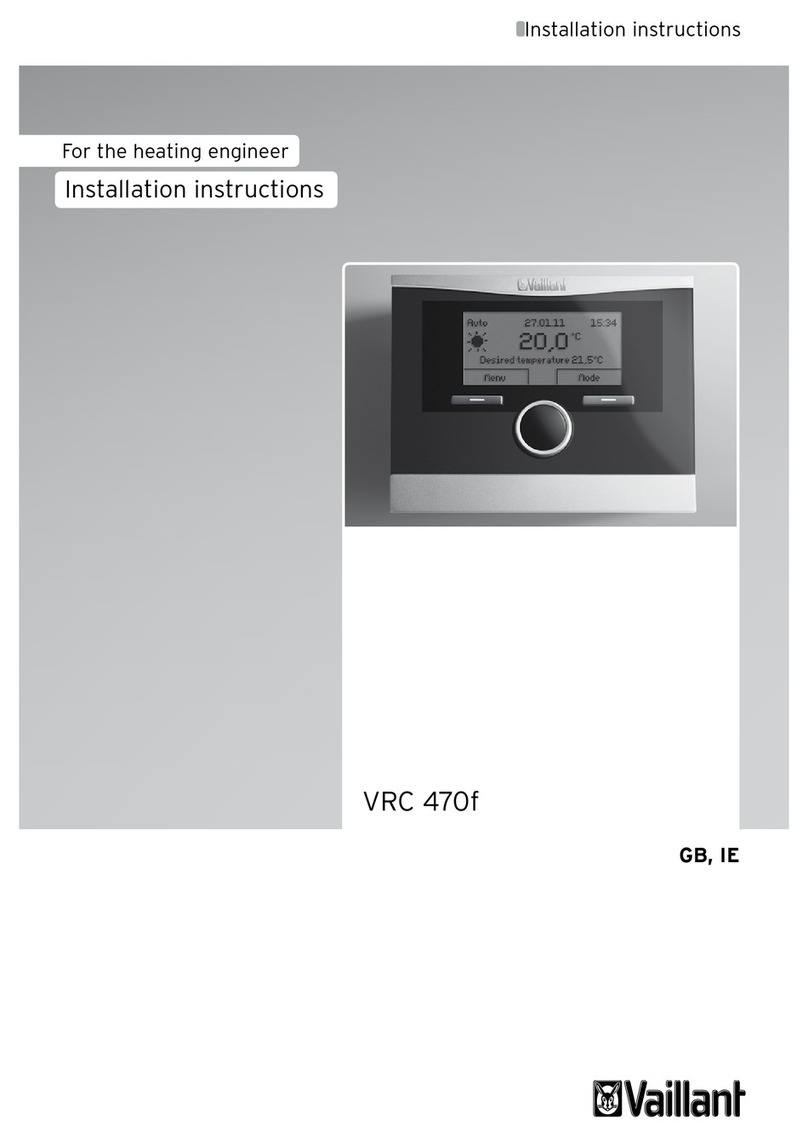
Vaillant
Vaillant VRC 470 installation instructions
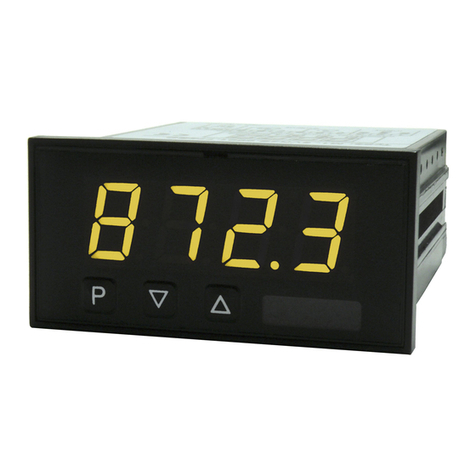
montwill
montwill M1 user manual
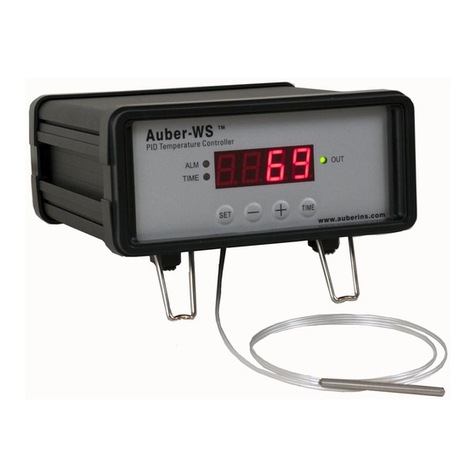
Auber Instruments
Auber Instruments WS Series Operation & instruction manual
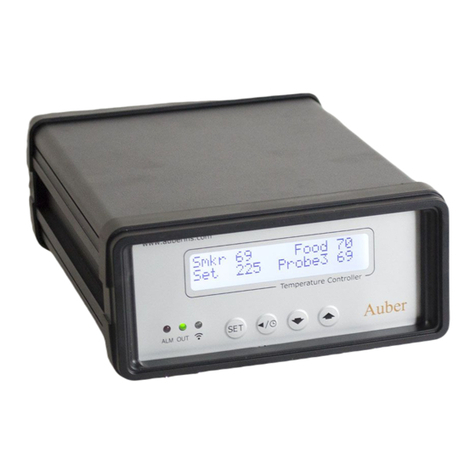
Auber Instruments
Auber Instruments WSD-1500H-W Operation & instruction manual
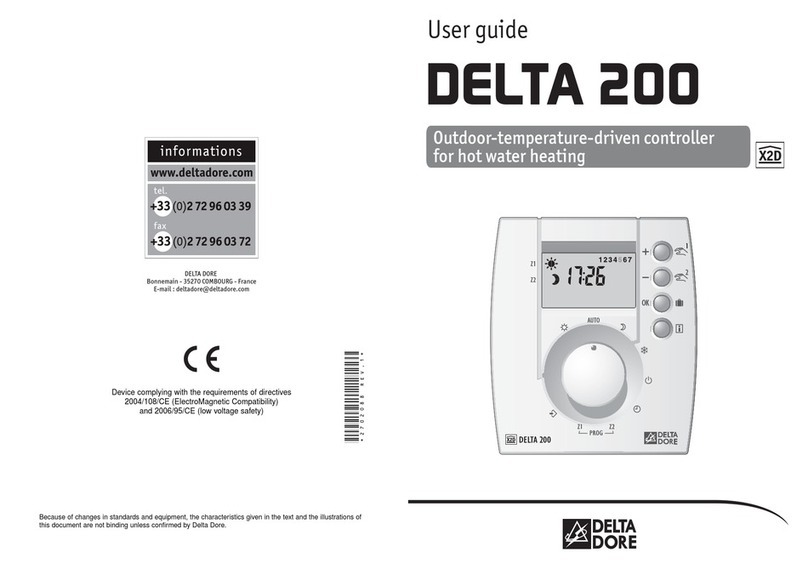
DELTA DORE
DELTA DORE DELTA 200 user guide

Oregon Scientific
Oregon Scientific THGN132N user manual
